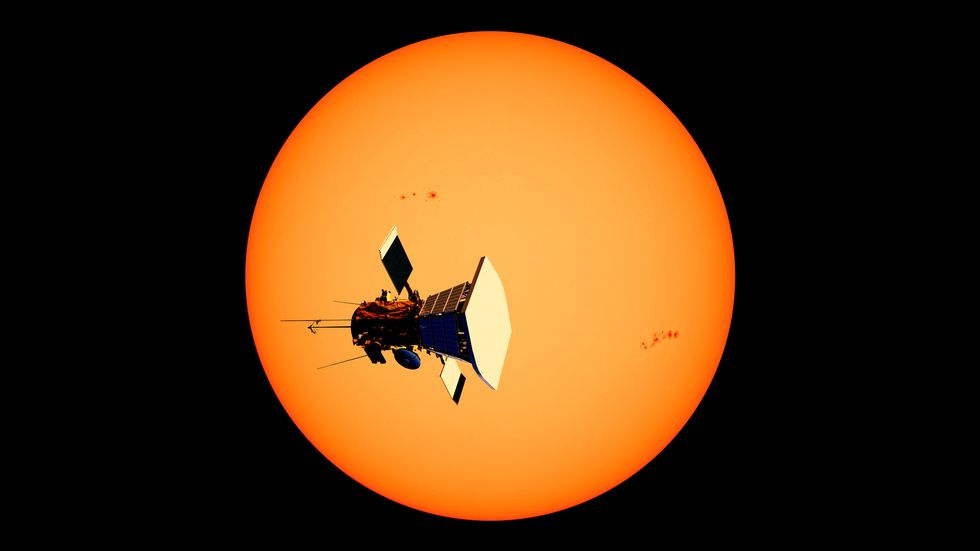Advertisement – Continue Reading Below
1
Parker Solar Probe

Originally launched in 2018, NASA’s Parker Solar Probe will reach the apex of its mission on Christmas Eve, 2024. That day, the spacecraft will come within 3.83 million miles of the Sun—the closest approach it will ever make.
With the Sun’s atmosphere estimated to end somewhere between 4.6 to 8.1 million miles from its “surface,” the probe will effectively “touch” our star.
NASA’s spacecraft will survive the experience thanks to its Venus-assisted high speed (around 430,000 mph), various cooling and shielding systems, and the Sun’s relatively dispersed atmosphere. Scientists hope this incredibly close approach will tell us more about solar particles and the waves found within solar winds.
Advertisement – Continue Reading Below
2
CRISPR Goes Mainstream

For 13 years, gene-editing therapies have been tantalizingly close with the development of clustered regularly interspaced short palindromic repeats, or CRISPR. This tech edits the genome and DNA to combat genetic diseases. In December 2023, the U.S. Food and Drug Administration (FDA) approved the very first CRISPR treatment in the U.S. for sickle cell disease, and the acceptance of CRISPR therapies will broaden in 2024.
The FDA is expected to approve another CRISPR therapy targeting beta thalassemia, a blood disease that affects the production of beta globin (a building block of the very important hemoglobin), in March 2024. And other similar FDA approvals—which experts say have generally recovered from the COVID-19 slump—could be on the horizon.
Advertisement – Continue Reading Below
3
The Launch of Europa Clipper Mission
Scientists think an ocean of water lies beneath Europa’s icy crust, so NASA is sending an orbiter to the Jovian moon to get a better look. The launch of Europa Clipper in October is only the beginning of a years-long mission—in fact, it’ll take the orbiter nearly six years to arrive at its destination in the outer Solar System. Once there, it’ll enter orbit around Jupiter and make some 50 flybys of Europa, the closest of which will be only 16 miles above the surface.
With each of these flybys approaching the moon from a different location, the surface of Europa will also be completely mapped using high-resolution cameras, and a suite of other science instruments will discern the Galilean moon’s suitability for life.
Advertisement – Continue Reading Below
4
Fighting Mosquitoes With…Mosquitoes
The U.S. Centers for Disease Control and Prevention (CDC) calls mosquitoes the “world’s deadliest animal” for good reason—these insects are the cause of 700,000 deaths every year.
In 2024, the World Mosquito Program will fight fire with fire by releasing billions of mosquitoes in Brazil engineered with the Wolbachia bacterium, which prevents the spread of disease. The hope is to specifically limit the spread of dengue fever, which causes a high fever, rash, and joint pain that sometimes leads to death. Brazil recorded the second most cases of dengue fever in the Americas in 2022, with roughly 1,104.5 cases per 100,000 people.
These altered mosquitoes could also help tamp down other mosquito-borne diseases, such as chikungunya, Zika virus, and yellow fever.
Advertisement – Continue Reading Below
5
Great North American Eclipse
April 8, 2024 will be a big space day for North America. Beginning along Mexico’s Pacific Coast at 11:07 AM PT, a total solar eclipse will cut its way across the continent, rivaling the eclipse event that fascinated the U.S. seven years earlier. The path of the eclipse in the U.S. will first pass over Texas, and then travel through Oklahoma, Arkansas, Missouri, Illinois, Kentucky, Indiana, Ohio, Pennsylvania, New York, Vermont, and New Hampshire before heading toward the Great White North through Maine. If you missed the North American eclipse in 2017, this is your last chance to see one until 2044. Just remember to pack protective eyewear!
Advertisement – Continue Reading Below
6
Solar and Wind Will Finally Outperform Coal in the U.S.
The dirty energy source behind the industrial revolution will finally meet its maker in 2024, as the U.S. expects wind and solar to out-produce coal by 90 billion kilowatt hours—the first year that’s ever happened in U.S. history. This milestone will be aided largely by an explosion of solar panel construction that is expected to add 37 gigawatts of capacity in 2024, increasing solar generation by nearly 40 percent.
The nation’s two largest offshore wind farms, Vineyard Wind off the coast of Massachusetts and South Fork Wind near Rhode Island, will also start pumping out electrons in 2024—and that’s not the only piece of good news.
Also in 2024, Dominion Energy in Virginia will start construction on the Coastal Virginia Offshore Wind Farm, which will contain 176 turbines and will be the largest farm of its kind in the U.S. when it goes online in 2026.
It’s a step in the right direction, but more is needed in 2024 and beyond to avoid the most dire impacts of a warming world.
Advertisement – Continue Reading Below
7
AI Advances (and Much-Needed Regulation)
The big story of 2023 was the unprecedented rise of AI, especially OpenAI’s ChatGPT. And the plot will only thicken in 2024. AI will really explode once it reaches mobile phones, the 2024 Paris Olympics will display the technological power of AI-powered surveillance systems, and we’re likely to experience the headache of AI-generated content during the U.S. election.
But this unrelenting AI push will also begin to meet staunch regulation. At the end of 2023, the European Union passed new rules regarding AI, and in October, Biden passed an executive order regarding the safe development of AI in the U.S. It’s likely Congress will take up the matter in 2024.
